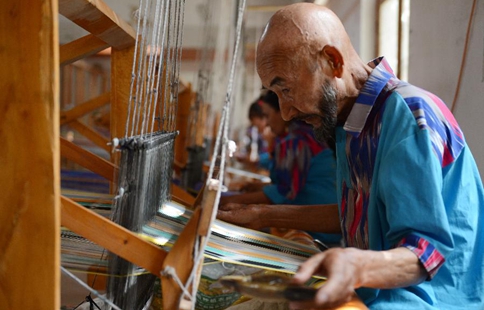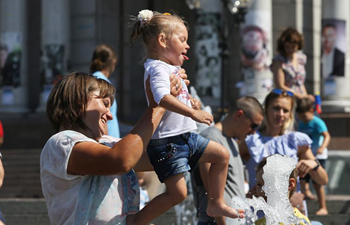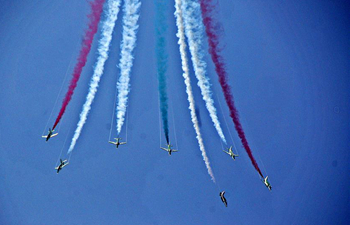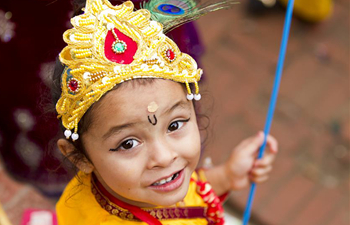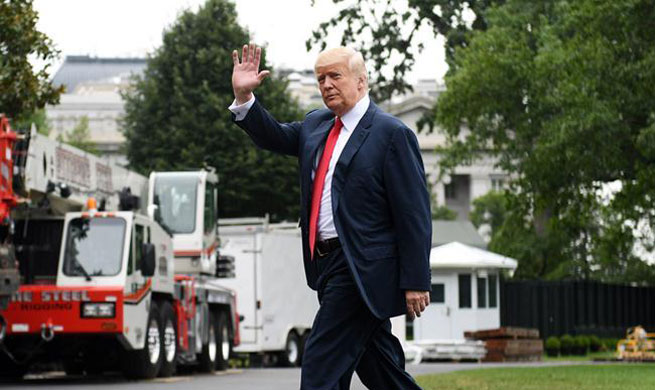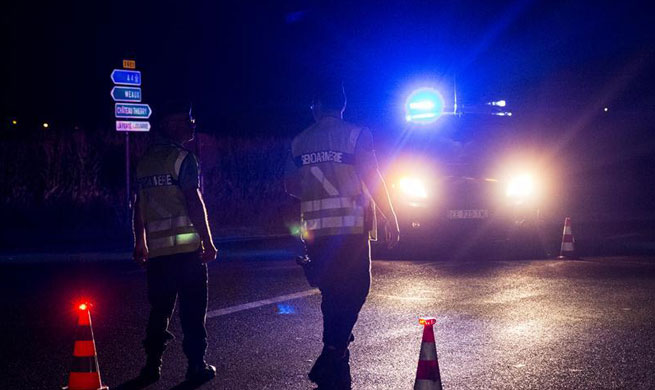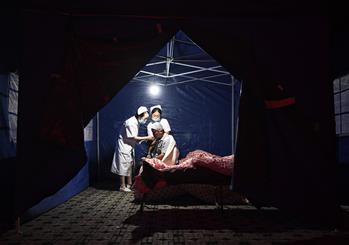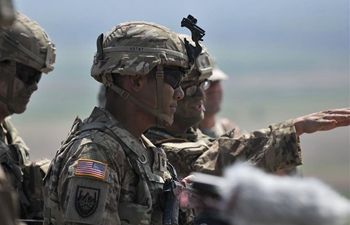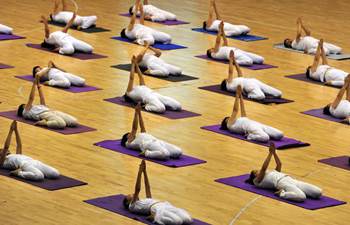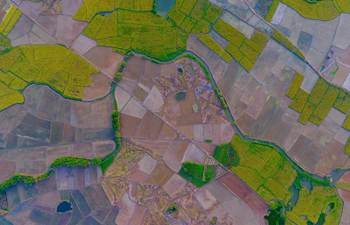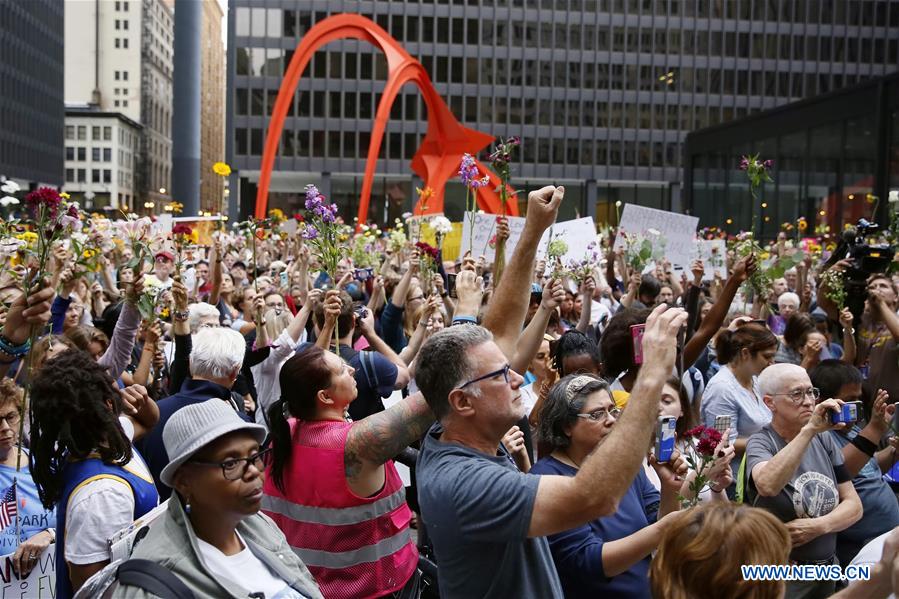
People raise flowers during an evening vigil at Federal Plaza in Chicago, the United States, on Aug. 13, 2017. Several hundred people joined a Sunday evening vigil at Federal Plaza in downtown Chicago, for those who fell victim to the violence in Charlottesville of Virginia during the weekend.(Xinhua/Wang Ping)
By Matthew Rusling
WASHINGTON, Aug. 14 (Xinhua) -- The United States is reeling after one woman died and several people were injured during the weekend's clashes between white power protesters and counter demonstrators. Experts fear such incidents could increase amid a recent jump in the number of white supremacy groups.
On Saturday, in the city of Charlottesville, Virginia, reports depicted a violent scene, in which white supremacists - and those demonstrating against them - threw fists, wielded sticks and shields and left each other bruised, bloodied and battered.
Suddenly and without warning, in the middle of the chaos, a driver plowed his car through a group of counter demonstrators, sending bodies flying into mid-air, killing one 32 year-old woman and wounding nearly two dozen more.
The weekend's violence underscores a growing white supremacy movement in the United States. While such groups remain on the fringe, some experts fear their numbers could grow.
"What happened in Charlottesville is the toxic outcome of a growing neo-Nazi, white nationalist movement that has felt emboldened partially by some of President Trump' s statements," Dan Mahaffee, senior vice president and director of policy at the Center for the Study of Congress and the Presidency, told Xinhua.
"And more significantly (the groups have been spurred on) by the growth of right wing movements that have found an echo chamber in which to grow and flourish on the Internet," Mahaffee said.
The liberal Southern Poverty Law Center, which keeps tabs on hate groups, said in a report published earlier this year that the number of U.S.-based hate groups operating in 2016 rose to 917 - up from 892 in 2015, although the list included all hate groups, including anti-white hate groups comprising African Americans. The number is 101 shy of the all-time record set in 2011, but high by historic standards, the group said.
The organization said the radical right has been energized by U.S. President Donald Trump. Some on the radical right perceive Trump to be on their side, on comments he made during his campaign, in which he compared Mexican illegal immigrants to rapists during a speech in which he promised to stem the massive tide of illegal immigration into the United States.
Trump was blasted over the weekend for what critics said was dragging his feet on condemning white hate groups such as the KKK and Neo Nazis, although on Monday Trump spoke from the White House on the issue, calling racism "evil" and lambasting Neo Nazis and KKK members as "criminals and thugs."
Chapters of the KKK - a racist, white power group that was once powerful in the American South but has lost much of its former influence -- grew from 72 in 2014 to 190 last year. The group was invigorated by the 364 pro-Confederate battle flag rallies that took place after South Carolina took down the flag from its Capitol grounds following the 2015 massacre of nine black churchgoers by a white supremacist flag enthusiast in Charleston, South Carolina, according to the Southern Poverty Law Center.
Speaking of the weekend's protests, Mahaffee said: "Combined with other right wing militia movements, in the case of Charlottesville, they were better armed and better organized than the police," Mahaffee said.
Indeed, media reports said police failed to form a barricade between the two groups, which is standard police procedure in such cases, and seemed to be overwhelmed by the chaos.
"What is most concerning about Charlottesville is that at least one member appears to have adopted the car attack tactics that were utilized by ISIS, and the concern is that this will inspire copycats who want to carry out further acts of domestic terrorism," Mahaffee said, referring to a common method attack used by an Islamist terror group.
MORE VIOLENCE TO COME
Brookings Institution Senior Fellow Darrell West told Xinhua that, going forward, the United States may see more such violence if the lives of Trump supporters - many of whom voted for him because they were struggling financially -- do not see their lives improve.
"Trump supporters expect the President to make their lives better. If that does not happen, they will be deeply disillusioned and likely to grow even more frustrated," West said.
That, West believes, could increase the number of those engaging in racism and political mayhem.
"There is the risk they will join other like-minded people and engage in racist behavior and political violence," he said.
"The coming years may be more volatile and tumultuous in the United States," he said.
WHITE, WORKING CLASS FRUSTRATION
The growth of such groups is a radical manifestation of myriad changes impacting white, working class Americans, a demographic that has felt the sting of joblessness in recent decades as factory jobs have moved down to Mexico or overseas.
Indeed, while the official U.S. jobless rate hovers around 5 percent, that figure only calculates those who are actively seeking full time employment, and many believe the real number is dramatically higher.
Millions of Americans - many are whites in rural areas - have given up seeking work on the utter lack of prospects. Moreover, critics say the rate skews the real situation. For example, an out-of-work engineer, who cuts his neighbor's lawn for one day and receives 20 U.S. dollars - enough to buy a couple of meals - is counted as employed for that entire week by the government bureau that compiles the U.S. jobless reports.
Many others are finding only part time work, although that situation differs sharply from the employment situation in major cities like Washington DC and New York. In those and other large cities, wages are high and jobs are abundant.
Moreover, many working class whites feel their lifestyle and belief systems are being threatened by what they see as an elite government in Washington that does not have their best interests in mind.
And at a time when there are 11 million illegal immigrants in the country, many believe - rightly or wrongly - that wages in such industries as construction are being driven down by illegal migrants.
This demographic has been angry for some time, and saw in Trump someone who would put them back to work, deport illegal migrants they believed were taking their jobs, and correct what they saw as unfair trade practises they feel threatened their livelihood.
Many Trump supporters, however, are quick to point out that the weekend's violence constitutes only a fringe group of Trump supporters. Others point out that most Americans are not as focused on the nation's political situation as are vocal minorities on both sides.
Some non-radical Trump supporters argue that it is not Trump's fault that right-wing radicals follow him, and contend that many radical whites have interpreted Trump's statements to mean whatever the radicals want them to mean.
Others maintain that every word out of a U.S. president's mouth can have consequences, and Trump must be much more careful with what he says, as he is known for emotional outbursts and over-the-top statements.




